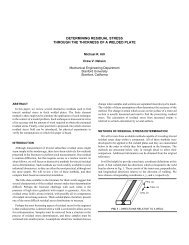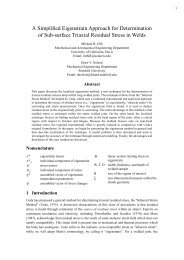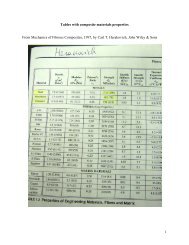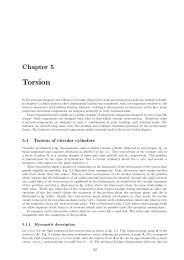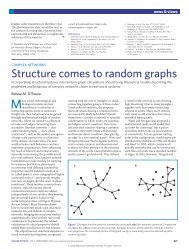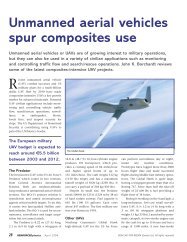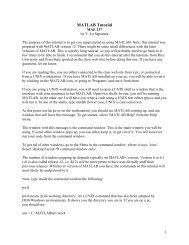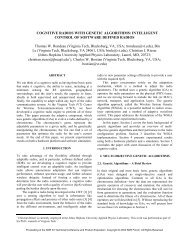Pythagorean-hodograph curves in Euclidean spaces of dimension ...
Pythagorean-hodograph curves in Euclidean spaces of dimension ...
Pythagorean-hodograph curves in Euclidean spaces of dimension ...
You also want an ePaper? Increase the reach of your titles
YUMPU automatically turns print PDFs into web optimized ePapers that Google loves.
• L<strong>in</strong>ear case. If all components <strong>of</strong> r ′ (t) vanish, r(t) is just a s<strong>in</strong>gle po<strong>in</strong>t. Assume then<br />
that some component <strong>of</strong> r ′ (t), denoted by δ(t), is non–zero. Then r(t) is a straight l<strong>in</strong>e if<br />
and only if all components <strong>of</strong> r ′ (t) are scalar multiples <strong>of</strong> δ(t). Suppose first that x ′ 1(t) =<br />
A(t) 2 − B(t) 2 = 0, and take this to be δ(t). Then A(t) B ∗ (t) = δ(t)v where v ∈ R n−1 ,<br />
which implies that δ 2 (t) = ν A(t) 2 B(t) 2 for some ν > 0. But this is possible if and only<br />
if A(t) = c B(t) for c ∈ R. Therefore, δ(t) = γ B(t) 2 , and from A(t) B ∗ (t) = δ(t)v<br />
we then have<br />
A(t) = δ(t)vB(t)<br />
B(t) 2 = C B(t) , where C ∈ Rn . (17)<br />
Now suppose that A(t) 2 −B(t) 2 = 0. Then, δ(t) is one <strong>of</strong> the components <strong>of</strong> A(t) B ∗ (t).<br />
Aga<strong>in</strong>, we have A(t) B ∗ (t) = δ(t)w for w ∈ R n−1 , and thus δ(t) = µ B(t) 2 , which br<strong>in</strong>gs<br />
us to the previous case.<br />
Notice that s<strong>in</strong>ce A(t) = C B(t) and <strong>in</strong> (5) we may take gcd(A, B) = 1, we see that A and<br />
B are both primitive. We summarize the above as follows.<br />
Proposition 4.1 Let r(t) be a PH curve with <strong>hodograph</strong> r ′ (t) def<strong>in</strong>ed by (5), where we<br />
have gcd(A(t), B(t)) = 1. Then r(t) is l<strong>in</strong>ear if and only if A(t) = C B(t), where C ∈ Rn<br />
and A(t), B(t) are both primitive.<br />
The l<strong>in</strong>earity condition A(t) = C B(t) <strong>in</strong>volves the unknown coefficient C. As observed <strong>in</strong><br />
Section 3, we may elim<strong>in</strong>ate it us<strong>in</strong>g Proposition 3.1 to obta<strong>in</strong> the equivalent condition<br />
B 2 A ∗ A ′ = A 2 B ∗ B ′ . (18)<br />
Conditions (17) and (18) become much simpler if we map r(t) to normal form. Let r ′ (t) =<br />
H(A(t), B(t)) and write A(t) = A0 + A1t + · · · + Amt m and B(t) = B0 + B1t + · · · + Bmt m .<br />
If we replace A(t), B(t) with MA(t) − N ∗ B(t), N A(t) + M ∗ B(t), where<br />
M =<br />
A ∗ m<br />
Am 2 + Bm 2 and N =<br />
− Bm<br />
Am2 ,<br />
+ Bm2 then A(t) becomes monic <strong>of</strong> degree m, while B(t) is <strong>of</strong> degree less than m. Henceforth, we<br />
call such a pair (A(t), B(t)) normal.<br />
In view <strong>of</strong> the above, we immediately have the follow<strong>in</strong>g.<br />
Corollary 4.1 Let r(t) be a PH curve with <strong>hodograph</strong> def<strong>in</strong>ed by (5), where (A(t), B(t))<br />
are normal. Then, r(t) is l<strong>in</strong>ear if and only if B(t) = 0.<br />
11





